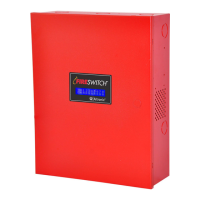
Do you have a question about the Altronix FireSwitch 108 and is the answer not in the manual?
| Output Voltage | 24VDC |
|---|---|
| Filtered & Regulated | Yes |
| Over Voltage Protection | Yes |
| Short Circuit and Thermal Overload Protection | Yes |
| Battery Backup | Yes |
| Fire Alarm Disconnect | Yes |
| Input Voltage | 120 VAC, 50/60 Hz |
| Supervision | AC Fail, Battery Presence |
| Weight | 8 lbs |
| Operating Temperature | 0ºC to 49ºC (32ºF to 120ºF) |
| Housing | Enclosure |
| Certifications | UL Listed |
Lists UL, cUL, FM, CSFM, NFPA compliance for fire alarm systems.
Details power input, FACP input, and 24VDC NAC output specifications and current ratings.
Covers AC/battery supervision, trouble reporting, and ground fault detection features.
Specifies battery requirements and visual indicators like the LCD display.
Details 2-wire sync modes, protocols, EOL programming, and Ethernet connectivity.
Specifies AC input, output ratings, battery requirements, and current consumption.
Lists stand-by current ratings for various battery configurations and auxiliary outputs.
Guides on wiring methods, enclosure mounting, and connecting power.
Details connecting AC input to the branch circuit and ground lug.
Illustrates connections for FACP inputs/outputs and Ethernet port.
Maps the terminal blocks for device connections and special applications.
Guides on selecting Class A, Class B, or Auxiliary using the joystick.
Details the 24VDC input and 1A auxiliary output terminals and their functions.
Explains the supervised NAC outputs, Class A/B connections, and FACP inputs.
Covers common trouble, synchronization, and ground fault reporting terminals.
Lists the maximum number of notification appliances synchronizable per circuit and per unit.
Details terminals for AC input (L, G, N) and 24VDC output (+DC-).
Explains the function of AC FAIL and BAT FAIL relay contacts for reporting status.
Describes the terminals for connecting the stand-by battery and charging.
Explains the meaning of Red (DC) and Green (AC) LEDs indicating power supply operating status.
Shows how AC input and supervision circuits are wired to the unit.
Illustrates the connections for the eight NAC outputs and the auxiliary output.
Depicts wiring for Ethernet communication and common trouble signaling.
Highlights the requirement to route power-limited wiring under the chassis.
Illustrates connections for FACP inputs/outputs and Ethernet port.
Maps the terminal blocks for device connections and special applications.
Guides on selecting Class A, Class B, or Auxiliary using the joystick.
Explains programming options for steady, Temporal Code 3, and Input-to-Output follower modes.
Details support for Amseco/Potter, Gentex, System Sensor, and CooperWheelock sync modes.
Covers programming for CO and Fire Alarm synchronization using specific modes.
Guides on programming End-of-Line resistor values for supervised outputs.
Covers clearing trouble memory and configuring AC/battery trouble reporting options.
Details procedures for testing output voltage and battery health.
Explains how to perform tests for ground faults, open circuits, and short circuits.
Details setting up laptop network connections (DHCP) for Windows OS.
Guides on connecting to the FireSwitch via Ethernet and opening the web interface.
Explains logging in with administrative credentials to access programming options.
Provides a worksheet for calculating stand-by and alarm current for the unit and auxiliary devices.
Guides on calculating total required battery capacity, including a 30% safety factor.
Covers unit versatility, synchronization capabilities, and FACP output integration.
Illustrates wiring for Class A, Class B, and combined circuit setups.
Explains how to configure outputs for CO and Fire Alarms, including trouble reporting logic.
Details wiring and programming modes for combined CO and Fire alarm signaling.
Guides on wiring non-synchronizable horns and strobes using specific input configurations.
Describes how to connect multiple FireSwitch units for synchronized operation from an FACP.
States the need for compatible devices and FACP sync protocol for synchronization.
Lists supported synchronization protocols for various manufacturers' devices.
Explains how Input 1 and Input 2 are used to control visual and audible notification appliances.
Explains the wiring for synchronizing up to twelve FireSwitch units.
Details the wiring for synchronizing up to four FireSwitch units.
Provides guidance on wiring to ensure loop integrity and supervision.
Illustrates wiring for Class A signaling using one FireSwitch unit.
Shows how multiple units can be programmed to follow Input 2 (2c).
Depicts the wiring for interconnecting up to four FireSwitch units.
Details the required INP2 Dip Switch settings for this application.
Guides on connecting both FACP outputs to the unit's inputs for single output operation.
Provides settings for DIP switches for dry contact and synchronization inputs.
Lists strobes, horns, and horn/strobes compatible with FireSwitch for synchronization.
Lists UL listed relays compatible with the FireSwitch AUX output and specific programmed outputs.
Shows precise measurements and diagrams for the enclosure's physical size and mounting.